2012 Mario Awards: Under the ‘Macrosope’
Las Vegas — What feels different at the 2012 NAB Show? It’s massive… but that’s nothin’ new. It’s more about bigness—and how that made it bigger.
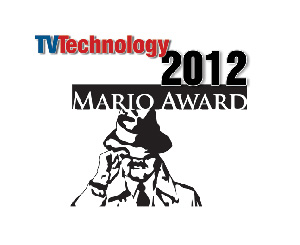
If you’ve been listening to attendees talk around town—and hey, that’s not really eavesdropping—then you’ve known for 15 or 20 years that the NAB Show isn’t just about TV. There’s this undercurrent of film folks—the denizens of Hollywood—who’ve infiltrated our ranks. At first, they came to see Fisher dollies and HMIs; but now that everyone’s got cinema-grade, large-format cameras, “big” is the word of the day—big chips, big storage, big monitors. And the focus has shifted to the “macro view” of how we all tell stories using pictures—TV people, Hollywood, the Indie folks and everyone else. And I’m just lovin’ it.
Join ole Uncle Mario, then, as I strap on the “Macroscope” in search of the big picture at the 2012 NAB Show exhibits.
Toshiba NP Engine: Maybe “NP” stands for “no processor” cycles used, as this purpose-built technology pushes video streams directly off SATA-connected storage without tying up the processor. No added cores—all that’s really needed is a task-enabled chip, not the whole megillah. Toshiba’s already got it implemented in their products, and it adds boatloads of capacity; watch for it to start appearing elsewhere, too.
Nori Square Bounce collapsible reflector set: We’ve seen lighting reflectors constructed in some pretty odd ways, but this one provides the most smiles per mile. Picture an umbrella, only square; and instead of parabolic, it’s planar. (That means flat.) Now, picture it in silver and in white. Picture yourself grabbing a long, sturdy handle that really makes it easy to hold. And picture the look on the AD’s face when you’re shading yourself between shots, and she’s halfway between sunburn and sunstroke.

Accepting the MARIO for the Toshiba NP Engine are (L-R) Rinarso Putoro Dimas, Shinichi Kurihara, Sunao Wada and Yoji Kume.
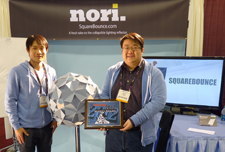
Kevin Wong (L) and Lyon Wong from Nori accept the MARIO for Square Bounce Collapsible Reflector Set
GoPro Protune Firmware with bundled Technicolor CineStyle: Using a tiny camera like the GoPro is no crime—sometimes POV tells the story best. But when all the other angles are covered by giant, high-res imagers, the resolution mix ain’t pretty. GoPro’s Protune firmware update jumps their H.264 output up from 16 Mbps to a quite respectable 35 Mbps, which is good enough for a meaningful pass through the included, GoPro-only version of the Technicolor Cine Style color correction app. Do the math: Small camera + small improvements = big-time results.
PRG Trucolor|HS soft lighting fixture: As a young sapling, I’d disassemble anything from a toaster to a tuba, just to see what made it tick. But the curious folks at Production Resource Group (PRG) split a white LED in half, looking to see where the light was made. The answer: high-efficiency blue LED cores excite white light-producing phosphors. Eureka! Use blue LEDs to wash a panel dusted with phosphors, and you get the PRG Trucolor|HS fixture—huge light output, perfectly even from corner to corner, long life and color stability. See, Ma, I told you that taking things apart didn’t always end badly.
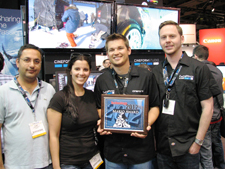
(L-R) Sumit Chawla, Jamie Oliver, Tim Bucklin and Adam McCauley from GoPro accept the MARIO for the company's Protune firmware
The professional video industry's #1 source for news, trends and product and tech information. Sign up below.

Trisha Maas (L) and Rich Pierceall of PRG Trucolor accept the MARIO Award for the company's HS Soft Light.
Dolby Labs & Philips Dolby 3D: An entire industry waits for 3D to flip from “maybe” to “must-have,” and Dolby and Philips are ready to lead us all to the promised land. “Glasses-free” is the Holy Grail of 3D; it might just be the one thing that delivers eyeballs to the 3D content distributors, and Dolby’s got it nailed. A new Dolby decoder chip drives garden-variety 3D TV panels, allowing them to display content that’s been encoded to the Dolby 3D standard. It’s a no-glasses, no-excuses implementation—looks great and could really change the way we watch TV. This is truly a game changer.
JK Audio Interloop: I’ve seen many a floor manager knit himself into a tangled web of intercom cable while scooting around the studio floor, so wireless is clearly the ticket. But in an era where everything’s Bluetooth, why not leverage some of that capability? The Interloop belt pack connects to your Bluetooth device, phone or whatever, and it’s time to hit the dusty trail. Or pair with your laptop, and bring a Skype connection to the com channel.
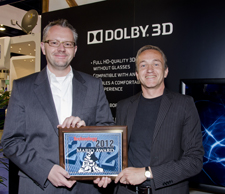
Roland Vlaicu (L) and Guido Voltolina accept the MARIO for Dolby Labs' Dolby 3D
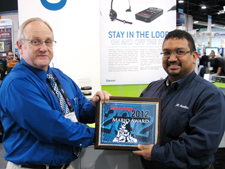
Alberto Colin (R), JK Audio technical support, accepts the MARIO Award from Joey Gill for JK's Interloop product.
Blackmagic Design Cinema Camera: It’s really the Swiss Army Knife of cameras—a 2.5K imager, plus HyperDeck recorder, plus a touch-LCD monitor, plus DaVinci color correction—and it’s cheaper than a discount-warehouse DSLR. Only Blackmagic could heap on the extra helpings like that and then slash the price to less than $3k, making it affordable right down into classrooms and church basements. If you’ve lusted after a big, fat cinema-grade camera, but you’re so stuck on trendy brand-name hype that you don’t grab this camera right away, take note: You’ve been shown up for the superficial fool you really are.
Sony NEX-FS700: I’ll confess: It’s not in my nature to root for the overdog. Can’t imagine that Big Ole Sony needs little ole Mario to audition for Number One Fanboy. But when it comes to cameras these days, Sony is kickin’ butt and takin’ names. This year’s bombshell: A big-res brother for the little NEX-FS100. Soon, a firmware update will deliver 4K resolution, and if that’s what you need, it’s perfect for you. But if you merely want 2K, or even just HD— outrageous slo-mo is your bonus prize— gorgeous 240 fps in full 1920 HD, and faster at lower resolutions.
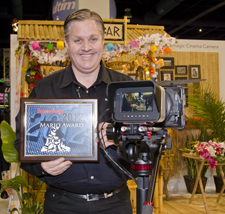
Grant Petty accepts the MARIO Award for Blackmagic Design's Cinema Camera.

Sony's Chiyoko Yannette accepts the MARIO for Sony's NEX FS700 E-mount camcorder.
Panasonic Micro P2: Panasonic’s ingenious P2 card design got the industry launched on safe, robust digital storage, and about 20 minutes later, people started looking for cheap knockoffs. Seems nutty that a big-time shooter would balk at buying the bulletproof media that safeguards his content. But the oracles of Secaucus have responded with market-friendly, SD-sized P2 media that leaves little to chance in terms of rock-solid storage.
Emotion3D Stereoscopic Suite X1 (SSX1): When you’re out shootin’ 3D somewhere, there are only about 196,000 things that could go wrong. Still, you’re expected to come back with your 3D geometry ultra-perfect to six decimal places. And by then, the mistakes are baked-in—it’s too late. Or is it? Despite a hefty price tag, the overwhelming ingenuity of Emotion3D’s SSX1 package might just let you save your bacon. This After Effects plug-in gives back all the controls you had—intra-ocular, parallax and all that good stuff. But the best part is a world-class GUI that shows exactly where your geometry resides: who’s in front of what, how deep the space is, and whether the audience needs Dramamine. Talk about a second chance—you actually get to un-bake the cake and fix it. That’s my kind of cookin’.
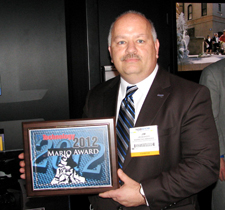
Panasonic's Jim Wickizer accepts the MARIO for Panasonic's Micro P2 storage media.

DI Florian Seltner accepts the MARIO for emotion3D's Stereoscopic Suite X1.
